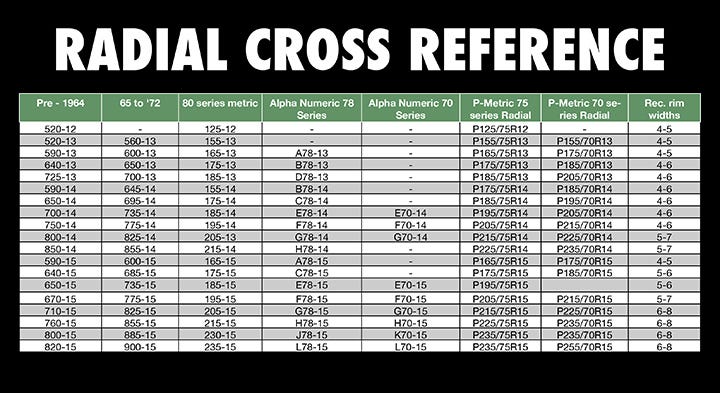Bias Ply and Radial Tire Size Cross Reference Chart

The Ultimate Tire Conversion Chart: Understanding Bias Ply and Radial Tire Sizes
Are you in the market for new tires? Perhaps you've heard about the two types of tire construction - bias ply and radial - but you don't quite understand the difference. Or maybe you're familiar with both types, but you're unsure about their size compatibility. Don't worry, we've got you covered. In this blog, we'll explain the basics of tire construction and provide an easy-to-use tire conversion chart to help you make an informed decision when buying new tires.
Understanding Tire Construction
Before diving into the world of tire sizes, it's important to understand the two main types of tire construction - bias ply and radial. These terms refer to how the tire is constructed, specifically how the layers of rubber and fabric cords are arranged.
Bias Ply Tires
Bias ply tires have been around for much longer than radial tires. They were first introduced in the 1930s and were commonly used on cars until the late 1970s. These tires are constructed by layering rubber-coated plies at an angle, usually 30-45 degrees, to the centerline of the tire. This diagonal pattern gives bias ply tires a sturdy construction and a distinct appearance that is correct for vehicles built before 1976.
Radial Tires
Radial tires were introduced in the late 1940s and have since become the standard for modern vehicles. Unlike bias ply tires, radial tires are constructed by layering rubber-coated plies at a 90-degree angle to the bead of the tire. This allows the tire to have more contact with the road, providing better handling and stability.
Bias Look Radial Tires
What exactly is a bias look radial tire? The simple explanation is that the physical profile of the tire is similar to its bias ply equivalent, while featuring a modern radial construction. Due to this, the sizing convention of a bias ply is used and an ‘R’ is added to denote radial construction. The result is a bias profile radial tire. Historically, there were many of these produced. In order to provide innovative and authentic products to enthusiasts, Coker Tire continues to develop and produce these unique tires.
Comparing Tire Sizes
Now that you understand the basics of tire construction, let's talk about size compatibility between the various construction types. Bias Ply and Radial tires have different sizing nomenclature, so finding a direct match isn’t always straightforward. However, with the help of our tire conversion chart, you can easily find compatible sizes for both types of tires.
Bias ply and radial tires have different construction methods, so handling characteristics differ between the two types. However, radial tires can be used as a direct replacement and a practical upgrade for bias ply tires, with special consideration for the sizing cross reference to ensure proper fitment. With the help of a tire conversion chart, it is easy to find equivalent sizes between the two construction types. Our chart features 8 sizing styles, ranging from early numeric bias ply sizes to modern P-metric radial sizes, including 1970’s alphanumeric sizes, which can be confusing.
When replacing tires, be sure to select the appropriate type and size for your vehicle. Consider factors like tire construction, dimensions, load capacity, and speed rating. Consult an expert if you are unsure of the proper tire fitment.
| Bias Ply Before 1964 | Bias Ply 1965 To 1972 | Bias Ply Alphanumeric 78 Series | Bias Ply Alphanumeric 70 Series |
Metric Radial 80 Series |
P-Metric Radial 75 Series |
P-Metric Radial 70 Series |
Bias Look Radial | Rec. Rim Width |
| 520-12 | - | - | - | 125R12 | P125/75R12 | - | - | 4-5 |
| 520-13 | 560-13 | - | - | 155R13 | P155/75R13 | P155/70R13 | - | 4-5 |
| 590-13 | 600-13 | A78-13 | - | 165R13 | P165/75R13 | P175/70R13 | - | 4-5 |
| 640-13 | 650-13 | B78-13 | - | 175R13 | P175/75R13 | P185/70R13 | 650R13 | 4-6 |
| 725-13 | 700-13 | D78-13 | - | 185R13 | P185/75R13 | P205/70R13 | - | 4-6 |
| 590-14 | 645-14 | B78-14 | - | 155R14 | P175/75R14 | P185/70R14 | - | 4-6 |
| 650-14 | 695-14 | C78-14 | - | 175R14 | P185/75R14 | P195/70R14 | - | 4-6 |
| 700-14 | 735-14 | E78-14 | E70-14 | 185R14 | P195/75R14 | P205/70R14 | - | 4-6 |
| 750-14 | 775-14 | F78-14 | F70-14 | 195R14 | P205/75R14 | P215/70R14 | 750R14 | 4-6 |
| 800-14 | 825-14 | G78-14 | G70-14 | 205R14 | P215/75R14 | P225/70R14 | 800R14 | 5-7 |
| 850-14 | 855-14 | H78-14 | - | 215R14 | P225/75R14 | P235/70R14 | - | 5-7 |
| 550-15 | 560-15 | A78-15 | - | 155R15 | - | - | 560R15 | 4-5 |
| 590-15 | 600-15 | A78-15 | - | 165R15 | P165/75R15 | P175/70R15 | - | 4-5 |
| 640-15 | 685-15 | C78-15 | - | 175R15 | P175/75R15 | P185/70R15 | - | 5-6 |
| 650-15 | 735-15 | E78-15 | E70-15 | 185R15 | P195/75R15 | P205/70R15 | - | 5-6 |
| 670-15 | 775-15 | F78-15 | F70-15 | 195R15 | P205/75R15 | P215/70R15 | 670R15 | 5-7 |
| 710-15 | 825-15 | G78-15 | G70-15 | 205R15 | P215/75R15 | P225/70R15 | 710R15 | 6-8 |
| 760-15 | 855-15 | H78-15 | H70-15 | 215R15 | P225/75R15 | P235/70R15 | 760R15 | 6-8 |
| 800-15 | 885-15 | J78-15 | K70-15 | 225R15 | P235/75R15 | P235/70R15 | 800R15 | 6-8 |
| 820-15 | 900-15 | L78-15 | L70-15 | 235R15 | P235/75R15 | P255/70R15 | 820R15 | 6-8 |
